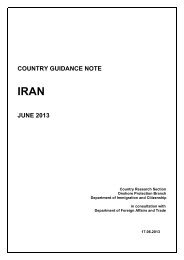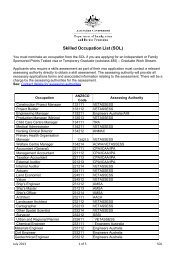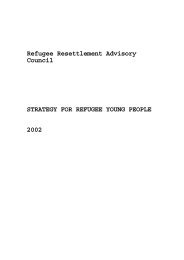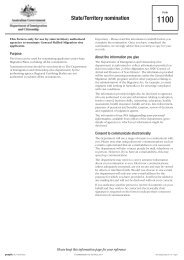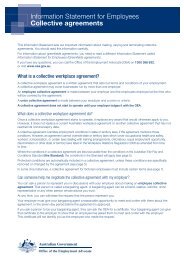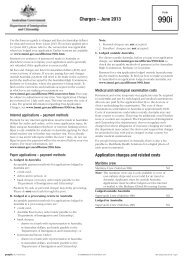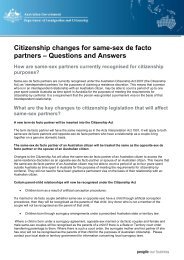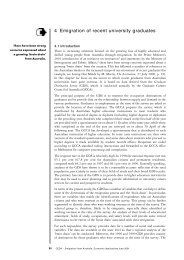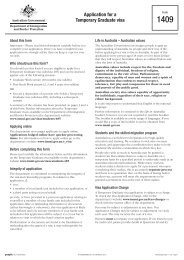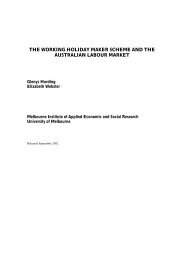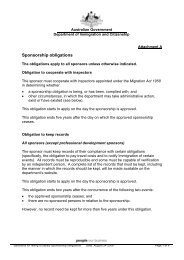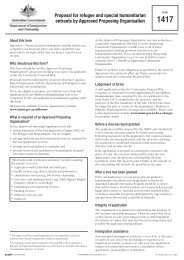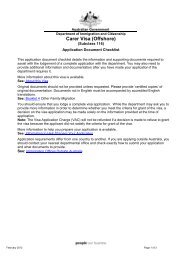Evaluation of the Integrated Humanitarian Settlement Strategy (IHSS)
Evaluation of the Integrated Humanitarian Settlement Strategy (IHSS)
Evaluation of the Integrated Humanitarian Settlement Strategy (IHSS)
You also want an ePaper? Increase the reach of your titles
YUMPU automatically turns print PDFs into web optimized ePapers that Google loves.
In response to this it needs to be noted that service providers and workers face a financial and/or<br />
personal disincentive in ‘over-servicing’ clients in that <strong>the</strong>y do so in paid or unpaid time. Having noted<br />
this, <strong>the</strong> question <strong>of</strong> whe<strong>the</strong>r clients are exited at an appropriate time still needs addressing.<br />
One answer lies in <strong>the</strong> nature and perceptions <strong>of</strong> longer term settlement services and concerns over<br />
continuity <strong>of</strong> service. Service providers who are confident that clients’ needs will be accommodated by<br />
longer term settlement and mainstream services were generally better able to move <strong>the</strong>ir clients on.<br />
Where <strong>the</strong> <strong>IHSS</strong> contracts sat with a MRC or similar larger organisation with longer term settlement<br />
responsibilities, <strong>the</strong> transition from initial to long term settlement tended to be relatively seamless. In<br />
particular, co-location <strong>of</strong> <strong>the</strong> IIOA and AS contracts was seen to be important.<br />
Ano<strong>the</strong>r factor that contributed towards service providers’ concern around exiting clients was <strong>the</strong><br />
degree to which mainstream agencies such as Centrelink, Medicare and community health services<br />
had demonstrated that <strong>the</strong>y can accommodate <strong>the</strong> special needs <strong>of</strong> newly arrived refugees. In one<br />
location, for instance, an arrangement had been made with Centrelink where an <strong>of</strong>ficer came to <strong>the</strong><br />
MRC on specified days to help new arrivals arrange social security issues. The Centrelink <strong>of</strong>ficer, in<br />
turn, worked within his own organisation to ensure that o<strong>the</strong>r <strong>of</strong>ficers were trained to respond to this<br />
particular client group. Clearly it is an advantage to establish such relationships. There are numerous<br />
examples where service providers have been able to establish effective working relationships with<br />
mainstream agencies which have resulted in better, streamlined outcomes for clients. However in<br />
order to develop <strong>the</strong>se links more readily, effort is required at both ends – from <strong>the</strong> mainstream<br />
agencies as well as <strong>the</strong> <strong>IHSS</strong> and PASTT service providers. There is also a need for both bottom-up<br />
(service level) and top-down (departmental level) effort on this issue.<br />
There is a lack <strong>of</strong> clarity about who has responsibility for developmental work within mainstream<br />
agencies. <strong>IHSS</strong> providers have a potential role, as do o<strong>the</strong>r services addressing longer-term<br />
settlement needs (eg MRCs, CSSS). There is a need to consider how to optimise <strong>the</strong> activities <strong>of</strong><br />
existing services and to identify where improvements may be made.<br />
The exit interview<br />
A primary mechanism through which appropriate handover <strong>of</strong> case responsibility occurs is <strong>the</strong> exit<br />
interview which is a requirement in <strong>the</strong> IIOA contract. The exit interview is a means <strong>of</strong> operationalising<br />
readiness to move beyond <strong>the</strong> initial settlement stage and services into longer term settlement<br />
services. In some instances formal exit interview protocols have been developed which assess <strong>the</strong><br />
client’s status (or residual need) in relation to a range <strong>of</strong> discrete services (eg income support,<br />
education and training, child care etc). What was not evident was clear agreement as to what<br />
constituted readiness to move on, nor how to measure or assess this. This reinforces <strong>the</strong> importance<br />
<strong>of</strong> establishing benchmarks for client outcomes under <strong>IHSS</strong>. In carrying out an exit interview and in<br />
assessing readiness an enormous amount <strong>of</strong> value judgement is involved. In regard to certain specific<br />
services (eg income support, health assessment) it is at least possible to determine whe<strong>the</strong>r a person<br />
has registered with Centrelink and is receiving <strong>the</strong> appropriate benefits, and whe<strong>the</strong>r <strong>the</strong> person has<br />
gone through a comprehensive physical examination by qualified personnel.<br />
However, what is <strong>the</strong> expectation in regard to o<strong>the</strong>r services eg employment or education and<br />
training? Aside from English classes, <strong>the</strong>se services, by definition, operate in a much longer time<br />
framework. Some IIOA service providers attempt to assess, as is appropriate, whe<strong>the</strong>r a client has<br />
actually received <strong>the</strong> necessary service, while o<strong>the</strong>r services assess <strong>the</strong> client’s understanding <strong>of</strong><br />
what general resources will be available to <strong>the</strong>m and, most importantly, where to go to access<br />
28<br />
<strong>Evaluation</strong> <strong>of</strong> <strong>the</strong> <strong>Integrated</strong> <strong>Humanitarian</strong> <strong>Settlement</strong> <strong>Strategy</strong> 27 May 2003



